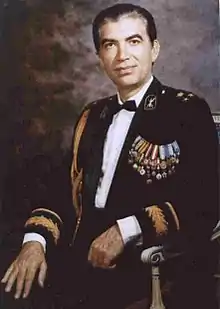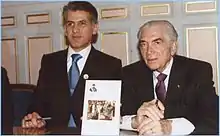Gholam Reza Pahlavi
Gholam Reza Pahlavi (Persian: غلامرضا پهلوی; 15 May 1923 – 7 May 2017) was an Iranian prince and a member of the Pahlavi dynasty, as the son of Reza Shah and half-brother of Mohammad Reza Pahlavi, the last Shah of Iran.
| Gholam Reza Pahlavi | |
|---|---|
 | |
| Born | 15 May 1923 Tehran, Sublime State of Persia |
| Died | 7 May 2017 (aged 93) Paris, France |
| Spouse |
|
| Issue | List
|
| House | Pahlavi |
| Father | Reza Shah |
| Mother | Turan Amirsoleimani |
Following the death of his half-sister Ashraf Pahlavi on 7 January 2016,[1] Gholam Reza became the only living child of Reza Shah. He resided in Paris with his family. He died on 7 May 2017 at the age of 93, eight days before his 94th birthday.
Early life and education
Pahlavi was born in Golestan Palace, Tehran, on 15 May 1923.[2][3] He was the fifth child and third son of Reza Shah, the founder of the Iranian Pahlavi dynasty.[4][5] His mother, Turan (Qamar ol-Molouk) Amirsoleimani, was related to the Qajar dynasty deposed in 1925 in favor of Reza Shah.[6] More specifically, she was the daughter of a Qajar dignitary, Issa Majd Al Saltaneh.[7][8][9] She was also the granddaughter of Majd ed-Dowleh Qajar-Qovanlu Amirsoleimani, Naser al Din Shah's maternal cousin.[2][9] Gholam Reza's parents married in 1922 and divorced shortly after his birth in 1923.[5][7]
He received primary education in Iran and then went to Switzerland for secondary education at Institut Le Rosey.[5][10] In 1936, he returned to the country and attended military school.[5] He accompanied his father, Reza Shah, to his exile in British Mauritius when the latter was forced to abdicate in September 1941.[5][11] In the aftermath of Reza Shah's abdication, the British and Russian envoys attempted to put Gholam Reza on the throne, bypassing Crown Prince Mohammad Reza Pahlavi when their efforts to end the Pahlavi dynasty and reinstate the Qajar dynasty failed.[12] It, however, also did not work.[12] Gholam Reza graduated from Princeton University.[11] In August 1952 while serving in the army Pahlavi joined a fourteen–week military training in Fort Knox, Kentucky.[13]
Career and activities
Upon returning to Iran, he attended military officers' training college for a military career. Pahlavi began his career in Iran's armed forces serving as a first lieutenant.[13] Then he served as inspector general in the army.[14][15] After holding different positions in the army he was promoted to the rank of lieutenant general in 1973.[14] He retired from the Iranian army as a brigadier general.[5]
In 1955, he became a member of the International Olympic Committee.[16] He also served as president of the Iranian National Olympic Committee.[17] He was a member of the Royal Council which ruled Iran during the international visits of Mohammad Reza Pahlavi.[18]
In early December 1973, he and his wife officially visited China just before the first Iranian ambassador, Abbas Aram, began to serve in that country.[19] As president of the Iranian national Olympic committee, he supported China's objection to Taiwan's participation in the 1976 Montreal Olympic Games.[20] However, he never tended to play an active role in domestic politics.[21]
During the reign of Mohammad Reza Pahlavi, he owned land in Iran and was a large shareholder in six firms.[22] Gholam Reza Pahlavi was a member of the construction society together with Ashraf Pahlavi and Teymur Bakhtiar.[23] It was established by the Shah to get contracts for municipal and road construction projects, and the members were given certain amounts from the profits.[23] Gholam Reza Pahlavi involved in a corruption case when he took payment from an East European country which made an investment contract with Iran.[24] Following the warning of Iranian economy minister, Alinaghi Alikhani, the Shah ordered him to return the payment.[24]
Personal life and later years

Pahlavi married Homa Aalam in 1948 in Tehran.[2] They had a daughter, Mehrnaz (born 4 February 1949), and a son, Bahman (born 30 January 1950).[9] They divorced in 1956, and he married Manijeh Jahanbani, a Qajar princess,[9] in Tehran on 6 March 1962.[2] This marriage produced two daughters and a son:[4] Azardokht (Khadijeh) Pahlavi, Maryam (Zahra) Pahlavi and Bahram Pahlavi.[25]
Pahlavi left Iran before the 1979 revolution along with other relatives.[22] He settled in Paris. In the immediate aftermath of the revolution, Ayatollah Sadegh Khalkhali, a religious judge and then chairman of the Revolutionary Court, informed the press that a death sentence was passed on the members of the Pahlavi family, including Gholam Reza and other former Shah officials.[26]
In 1996 Pahlavi was diagnosed with lymphoma.[2] He died at the age of 93 at the American Hospital of Paris on 7 May 2017.[27]
Book
Pahlavi published a book, Mon père, mon frère, les Shahs d'Iran (French: My father, my brother, the Shahs of Iran), in 2005, dealing with both his experiences and thoughts about the future of Iran.[28] The book was published in French and Persian (ISBN 2915685061).[28]
Honours
National honours
 Knight Grand Cross of the Order of Pahlavi
Knight Grand Cross of the Order of Pahlavi_Ribbon_Bar_-_Imperial_Iran.svg.png.webp) Order of Glory
Order of Glory_Ribbon_Bar_-_Imperial_Iran.svg.png.webp) Order of Military Merit, 2nd class
Order of Military Merit, 2nd class_Ribbon_Bar_-_Imperial_Iran.svg.png.webp) Order of Service, 2nd class
Order of Service, 2nd class_Ribbon_Bar_-_Imperial_Iran.svg.png.webp) Order of Rashtakhiz, 1st class
Order of Rashtakhiz, 1st class National Uprising Medal [28th Amordad 1332 Medal] (1953)
National Uprising Medal [28th Amordad 1332 Medal] (1953) Imperial Coronation Medal (26 October 1967)
Imperial Coronation Medal (26 October 1967)
Foreign honours
_-_ribbon_bar.gif) Order of the Supreme Sun, 1st Class (Kingdom of Afghanistan)
Order of the Supreme Sun, 1st Class (Kingdom of Afghanistan) Knight Grand Cross of Royal Order of Isabella the Catholic (Kingdom of Spain, 1978)
Knight Grand Cross of Royal Order of Isabella the Catholic (Kingdom of Spain, 1978) King Birendra Coronation Medal (Kingdom of Nepal, 24 February 1975)
King Birendra Coronation Medal (Kingdom of Nepal, 24 February 1975)
References
- Liam Stack (8 January 2016). "Ashraf Pahlavi, Sister of Iran's Last Shah, Defender and Diplomat, Dies at 96". The New York Times. Retrieved 8 January 2016.
- "Ma biographie". Official website of Gholam Reza Pahlavi (in French). Retrieved 27 July 2023.
- Iman Ansari; Patrick Germain. (eds.). (2005). Mon père, mon frère, les Shahs d’Iran: Entretiens avec Son Altesse Impériale le prince Gholam-Reza Pahlavi, Éditions Normant ISBN 2915685061, p.24
- "The Imperial Regime was not a model of Democracy but?". Rozaneh Magazine. November–December 2005.
- Gholamali Haddad Adel; Mohammad Jafar Elmi; Hassan Taromi-Rad, eds. (2012). Pahlavi Dynasty: An Entry from Encyclopaedia of the World of Islam. London: EWI Press. p. 172. ISBN 978-1-908433-01-5.
- Cyrus Ghani (2001). Iran and the Rise of the Reza Shah: From Qajar Collapse to Pahlavi Power. London: I.B.Tauris. p. 194. ISBN 978-1-86064-629-4.
- "Reza Shah Pahlavi". Iran Chamber Society. Retrieved 16 July 2013.
- Mehdi Jangravi. "Reza Shah's Wives". Institute for Iranian Studies. Retrieved 31 October 2012.
- "The Qajars (Kadjars) and the Pahlavis". Qajar Pages. Archived from the original on 28 July 2012. Retrieved 31 October 2012.
- US Spy Nest Documents (in Persian). Vol. 7. دانشجويان مسلمان پيرو خط امام،. 2012. p. 88. ISBN 978-964-5645-75-3.
- Mohammad Gholi Majd (2001). Great Britain and Reza Shah: The Plunder of Iran, 1921-1941. Tampa, FL: University Press of Florida. p. 320. ISBN 978-0-8130-2111-9.
- Fariborz Mokhtari (Spring 2005). "No One will Scratch My Back: Iranian Security Perceptions in Historical Context". The Middle East Journal. 59 (2): 209–229. doi:10.3751/59.2.12.
- "Iranian Prince Here for Army Training". The New York Times. 9 August 1952. p. 4. ProQuest 196403. Retrieved 27 July 2022.
- "Prince Gholam Reza Pahlavi". Foundation for Iranian Studies. Archived from the original on 21 September 2013. Retrieved 31 October 2012.
- Edgar Burke Inlow (1979). Shahanshah: The Study of Monarchy of Iran. Delhi: Motilal Banarsidass. p. 91. ISBN 978-81-208-2292-4.
- "The Olympic Games" (PDF). International Olympic Committee. Lausanne. 1962. Retrieved 19 July 2013.
- "Address by H.I.H. Prince Gholam Reza Pahlavi" (PDF). LA 84 Foundation. Retrieved 31 October 2012.
- "Developments of the Quarter: Comment and Chronology". The Middle East Journal. 4 (1): 83–93. January 1950. JSTOR 4322139.
- John W. Garver (2006). China and Iran: Ancient Partners in a Post-Imperial World. Seattle: University of Washington Press. p. 308. ISBN 978-0-295-80121-6.
- "IOC put off decision on China issue". New Straits Times. 25 May 1975. Retrieved 4 November 2012.
- Ali Akbar Dareini (1999). The Rise and Fall of the Pahlavi Dynasty: Memoirs of Former General Hussein Fardust. Delhi: Motilal Banarsidass. p. 123. ISBN 978-81-208-1642-8.
- "105 Iranian firms said controlled by royal family". The Leader Post. Tehran. AP. 22 January 1979. Retrieved 4 November 2012.
- Michael J. Willcocks (2015). Agent or Client: Who Instigated the White Revolution of the Shah and the People in Iran, 1963 (PhD thesis). University of Manchester. p. 124.
- Vali Nasr (February 2000). "Politics within the Late-Pahlavi State: The Ministry of Economy and Industrial Policy, 1963-69". International Journal of Middle East Studies. 32 (1): 105. doi:10.1017/S0020743800021061. JSTOR 259537. S2CID 154803890.
- "Exemption from court fees in lawsuits against the heirs and relatives of the deceased king". Islamic Parliament Research Center of The Islamic Republic of IRAN (in Persian). Archived from the original on 18 November 2021. Retrieved 21 April 2021.
- "No Safe Haven: Iran's Global Assassination Campaign". Iran Human Rights Documentation Center. 2008. Retrieved 4 August 2013.
- "Gholam Reza Pahlavi Passes Away". BBC Persian. 2017. Retrieved 7 May 2017.
- Iman Ansari (2006). "Entretien avec Son Altesse Impériale le prince Gholam-Reza Pahlavi". Outre-Terre (in French). 3 (16): 57–60. doi:10.3917/oute.016.0057.
External links
- Gholam Reza Pahlavi's official website
 Media related to Shapour Gholamreza Pahlavi at Wikimedia Commons
Media related to Shapour Gholamreza Pahlavi at Wikimedia Commons